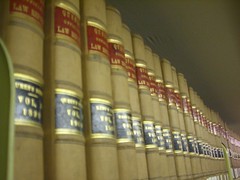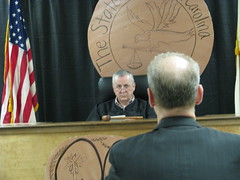Applying Robert Merton’s “The Normative Structure of Science” to the law
By Kristopher A. Nelson
in
December 2009
900 words / 4 min.
Tweet
Share
Robert Merton, in “The Normative Structure of Science” (from The Sociology of Science: Theoretical and Empirical Investigations), posits four sets of “institutional imperatives” that together “comprise the ethos of modern science”: universalism, communism, disinterestedness, and organized skepticism. How well do these four sets of imperatives describe the “ethos of modern law”?
Please note that this post is from 2009. Evaluate with care and in light of later events.
As part of an irregular series focusing on my graduate work in law and technology, I’m going to occasionally highlight some of the more theoretical material I work on:
Robert Merton, in “The Normative Structure of Science” (from The Sociology of Science: Theoretical and Empirical Investigations), posits four sets of “institutional imperatives” that together “comprise the ethos of modern science”: universalism, communism, disinterestedness, and organized skepticism. How well do these four sets of imperatives describe the “ethos of modern law”?
 First, according to Merton, science should be universal. That is, the “acceptance or rejection of claims” should not depend on “personal or social attributes of their protagonist,” including “race, nationality, religion, class, and personal qualities.” “Objectivity,” writes Merton, “precludes particularism,” and science is independent of particular ideologies or nationalities. Merton, in fact, explicitly connects norms in science with norms of law: “the ethos of democracy includes universalism,” he writes, further arguing that the “political apparatus [i.e., statutory law, regulatory agencies, and so on] may be required to put democratic values into practice and to maintain universalistic standards.”
First, according to Merton, science should be universal. That is, the “acceptance or rejection of claims” should not depend on “personal or social attributes of their protagonist,” including “race, nationality, religion, class, and personal qualities.” “Objectivity,” writes Merton, “precludes particularism,” and science is independent of particular ideologies or nationalities. Merton, in fact, explicitly connects norms in science with norms of law: “the ethos of democracy includes universalism,” he writes, further arguing that the “political apparatus [i.e., statutory law, regulatory agencies, and so on] may be required to put democratic values into practice and to maintain universalistic standards.”
Despite having a national and regional character, Merton’s universalism permeates American visions of what the law should be. Thus, there are strict limits on the ways that race, national origin, and so on can be taken into account under the law, and judges and juries are expected to dispense with ideology when “finding facts” and ruling on legal issues. They are instead entreated to simply “apply the law” in a uniform and impartial manner. Of course, in law as in science, the implementation of universalism is imperfect, and may at times be “affirmed in theory and suppressed in practice.”
 A second Mertonian element of science is what he terms “communism,” in which the “substantive findings of science are a product of social collaboration and are assigned to the community.” The American and English common law system is a particularly good example of this approach: as with Merton’s conception of “the essentially cooperative and selectively cumulative quality of scientific achievement,” the common law consists of, and builds upon, all the legal work that has come before. Even our general (if occasionally contested) rule that statutory law is not subject to copyright builds on this communitarian vision.
A second Mertonian element of science is what he terms “communism,” in which the “substantive findings of science are a product of social collaboration and are assigned to the community.” The American and English common law system is a particularly good example of this approach: as with Merton’s conception of “the essentially cooperative and selectively cumulative quality of scientific achievement,” the common law consists of, and builds upon, all the legal work that has come before. Even our general (if occasionally contested) rule that statutory law is not subject to copyright builds on this communitarian vision.
Disinterestedness is the third element of Mertonian science. It refers to a sense of moral integrity and ethical pursuit, along with a removal of personal or ideological end goals. Certainly this same goal is integral to the practice of law, especially as embodied in judges. In this sense, interestedness by a potential juror is grounds for exclusion. Ethical standards are explicit and exacting for attorneys, even if — apparently unlike scientists in Merton’s day — the general population has a low regard for the ethical standards of lawyers. (Interestingly, scientists have no such formal ethical guidelines.) Personal interests are to be set aside, and the interests of the client (or of “the people” or similar abstract notion of societal interest) are to be substituted instead. This may well point out a distinction between a scientists and lawyers (other than judges, at least): scientists might claim to be putting science and the facts first, but lawyers are up front about putting the client first, and letting the so-called “adversarial system” sort out the truth — although despite this, lawyers have ethical obligations to at least avoid perpetuating falsehood.
Finally, and relatedly, “organized skepticism is variously interrelated with the other elements of the scientific ethos.” It requires a “temporary suspension of judgment and the detached scrutiny of beliefs in terms of empirical and logical criteria.” Certainly this same approach is expected of judges and juries, although lawyers representing their clients are expected to balance skepticism with belief in their client, and focus their skepticism on opposing counsel and their arguments. Once again in the law, the adversarial system, combined with disinterested and objective judges and juries, is supposed to ferret out the truth.
Whether science imitates the law, or law imitates science, or both are responding to larger societal pressures to conform to certain standards (such as Merton’s theory that Puritanism contributed to the growth of modern science), the ideal scientist similar to an ideal lawyer (and even more like the ideal judge). Unlike attorneys, however, the ideal scientist represents truth, not a client and her interests. Lawyers explicitly recognize and speak of the need for a social system — the courtroom, its adversarial system and arbiters — to get at the truth. But perhaps because scientists do not generally acknowledge serving a “client,” even when they work for a corporation, the existence of a social system constructing science is less obvious to many. This is true even though scientists themselves realize how necessary, for example, peer reviewed journals are to the production of scientific truth.
Excerpted from “Constructing a Useful Theory of Knowledge,” available in draft form at SSRN.
